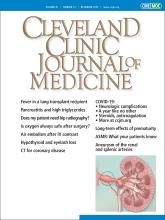To the Editor: The article by Nagaraja and Lincoff1 is an excellent review of the International Study of Comparative Health Effectiveness With Medical and Invasive Approaches trial. It highlights the continuing evolution of patient-centered approaches in the management of stable coronary artery disease. Their algorithm contains the phrase “cardiac computed tomography to assess calcium score and exclude left main disease.” Are the authors referring to the coronary artery calcium score (CACS) or coronary computed tomography angiography (CCTA)? I believe they mean the latter, but as both are computed tomographic modalities of the heart and the difference may not be readily appreciated by a general medicine audience, it may be helpful to clarify.
The CACS is most useful in risk assessment in primary prevention, particularly to improve specificity in older adults and allow for a personalized and risk-driven decision in use of lipid-lowering medications. For patients with established coronary artery disease and an abnormal stress test, it seems unlikely that the CACS will add any clinically useful information and may provide false reassurance, particularly in exclusion of disease. Noncalcified plaque, including that in the left main, would not be visible on CACS.
Further, it is noncalcified plaque that is the strongest risk-discriminator. The incidence of acute coronary syndrome is associated with fibrofatty plaques and plaques with necrotic cores (both generally low-density, noncalcified plaque types that are not visualized by CACS), but not calcified plaque burden.2 Calcium development is a late-stage finding of a plaque, and high-risk atherosclerotic plaque features, such as rupture and erosion, are missed by CACS.3 In fact, heavily calcified (stabilized) plaques appear to be protective.4
On the other hand, CCTA evaluates the entire spectrum of coronary artery disease and can identify noncalcified plaque. It would be the appropriate modality to exclude left main disease, as I believe the authors are proposing.
- Copyright © 2020 The Cleveland Clinic Foundation. All Rights Reserved.






